Pilgrimage – The Tibetan Holy Quest
One of the most amazing sights on the Tibetan plateau is not the stunning palaces, ancient temples, and high mountains, but is something more base and simple, and down to earth. All across the region, throughout the year, Tibetan pilgrims can be seen walking, riding, or even prostrating along the side of the road towards their holy destination. Pilgrimage is a ritual act of the Tibetan Buddhists, where the pilgrims travel for hundreds of miles across the plateau to reach a sacred site in order to circumambulate the site and pray in front of or inside it. This ritual has been going on for more than a thousand years, and is still done in much the same way today as it was at the dawn of Tibetan Buddhism.
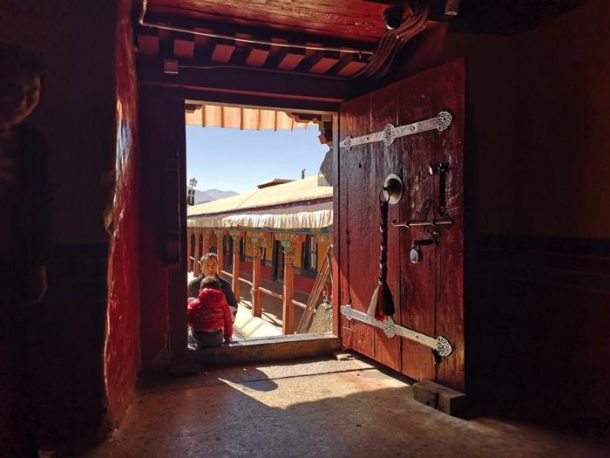
Table of Contents
Prostration Pilgrimage to Lhasa
For Joama and her three cousins, who are yak herders from the remote northern grasslands of the Tibet Autonomous Region, it was already June when they embarked on their sacred journey across the vast expanse of the plateau. For Joama, this is an once-in-a-lifetime experience, and she may never get the chance to do it again. It has been her lifelong dream to make the journey to Lhasa to pray at the Jokhang Temple, and at just 24 and not yet married, it was the perfect time to free up the time to make the pilgrimage.
It was late in June when the four cousins set off from the Changtang Grasslands to the far north of Lhasa, to make the journey of almost 500 kilometers to the Tibetan capital. The start of the journey was simple, with no ceremonies. From outside their small home in northern Nagqu Prefecture, the four simply dropped to their knees, flung their bodies forward, and lay face down, prone against the damp ground, before lifting back to their feet, taking three small steps, and then doing it all again.
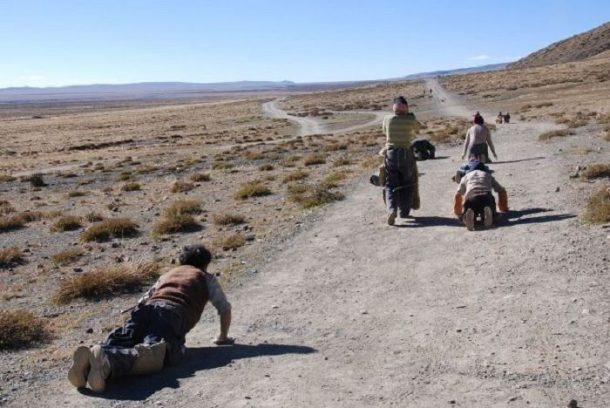
For five months, the group made their way to Lhasa by this means, inching their way closer to the Tibetan capital day by day, starting from an altitude of more than 4,300 meters, traveling more than 160 kilometers to the main highway from Qinghai Province to Lhasa at Nagqu City, and then another 330 kilometers to Lhasa. Traveling through some of the harshest in Tibet, these devout Buddhists saw joy in every step.
It was November when the group finally made it to the hallowed city of Lhasa, inching their way along the busy sidewalks of the city towards their final destination, the Jokhang Temple. There, they spent two days performing the ritual kora around the sacred temple, before entering to pray at the holy shrines inside. After the Jokhang Temple, they all moved up to the Potala Palace, to bow before the tombs of the ancient Dalai Lamas.
Devotion to Buddhism
While the devotion to Buddhism may seem to be waning with the young urban professionals in the big cities of Lhasa and Shigatse, out in the hinterlands, it is still strong and remains a source of joy for the resilient farmers and nomads that live their lives in the harshest environments on the planet. Young people like Joama are still in touch with their faith, and the devotion to Buddhism is still as strong now as it was in ancient times.
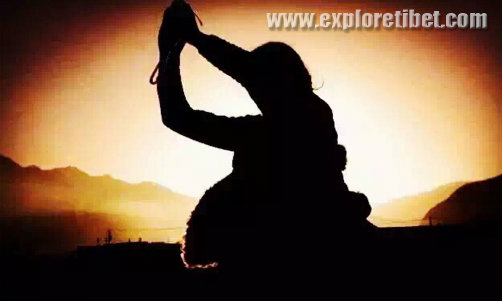
Prostration is the ultimate symbol of submission, and while there may be fewer pilgrims that make the journey in this manner to the sacred sites, this unique quest for inner peace and harmony is still performed across the plateau. Nowhere else in the world would such an awe-inspiring spectacle of pilgrims prostrating themselves alongside the major roads in Tibet draw so little attention.
The Joy of Prostration
Tserenduba is a 41-year-old father from Nagqu Prefecture, in a remote village more than 400 kilometers to the north of Lhasa. With nine other men and women, they left their village in the distant mountains to make the journey to Lhasa. According to him, prostrating along the pilgrimage route to Lhasa is a way to show their complete devotion to Buddha, and he considers it to be the best way to make a pilgrimage.
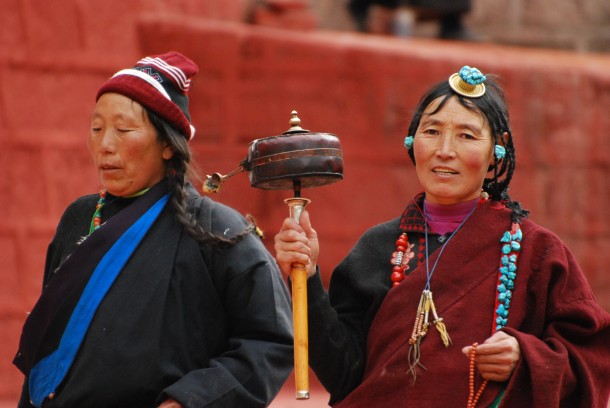
Leaving their village in the early part of August, the group has traveled over rough and rocky terrain to get to the roads, which make the journey a little easier. At the end of each day, their bodies are racked with pain, but they feel filled with joy that they are a little closer to their ultimate goal.
In Tibet, it is common for groups of pilgrims to travel with most prostrating themselves along the route while act as pack mules for their supplies and provisions. For Tserenduba’s group, three pull the cart that contains their supplies, provisions, and tents, while the other seven lucky pilgrims inch their way forward, protective leather aprons covering the lower half of their bodies to protect their knees, while thick pads strapped to their hands help to protect them from sharp stones and the permanently frozen ground. For them, they consider themselves lucky to be in the group that prostrates, rather than the group pushing the cart.
Alms for the Tibetan Pilgrims
Traveling this way is a common sight on the plateau’s many roads, and while a few groups will have carts, most travel with a simple pack, subsisting on alms from the local villages they pass through along the way. As devout Tibetan Buddhists, the villagers will always give something to the pilgrims as they pass through the small settlements en-route to Lhasa. The pilgrim is the devoted servant of Buddha, and the act of making a pilgrimage by prostration is something every Tibetan Buddhist wants to do at some point in their lives. Alms are their ways of helping the devotee finish his sacred quest.
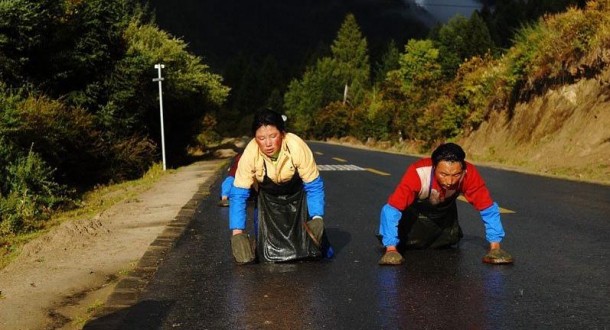
As with most pilgrims that travel to Lhasa from the farthest reaches of the plateau, both Tserenduba and Joama know very little of the depths of the Buddhist scriptures and the theories of Buddhism. These are things known only to monks in the remotest regions of Tibet. Like many of his peers, Tserenduba simply knows what he feels and believes; that this quest will bring him closer to happiness and joy in his life. For many of the pilgrims that head to Lhasa and the sacred Jokhang Temple, they do it so that their futures can be better.
The Shorter Road Home
For many pilgrims traveling to Lhasa or the other sacred sites across the plateau, it can take several months of prostrations to reach their final destinations, and once their prayers are done, they simply turn around and head home. After their long and arduous journey across the plateau, Joama and her cousins found a truck that was heading for Nagqu City and managed to hitch a ride that far with the driver, riding in the open back of the truck. For them, this is the luxury of completing their pilgrimage, riding in a truck most of the way home. From Nagqu City, they will likely have to walk the remaining hundred kilometers to their small homes.
Recent Posts
Top 5 Most Asked questions on Tibet Travel
7 Tips for a Successful Trip to Tibet
A Journey to Everest Base Camp in Tibet
All Categories
- About Tibet
- book a Tibet tour
- Buddhism Practice
- Budget Tour
- China-Tibet Train
- Customized Tibet tour
- Historical Sites
- Hot Springs in Tibet
- News
- Photography in Tibet
- Tibet attraction
- Tibet Group Visa
- Tibet Motorcycle Tour
- Tibet Small Group Tours
- Tibet Tours and Tibetan Tour Guide
- Tibet Train
- Tibet Travel FAQs
- Tibet Travel Information
- Tibet Travel News
- Tibet Travel Permit Update
- Tibet Travel Prices Rises
- Tibet Trek
- Tibet Trekking Tour
- Tibet weather and climate
- Tibet Wildlife animals
- Tibet Winter Tour
- Tibetan Buddhism
- Tibetan Cultural Features
- Tibetan Culture and Poeple
- Tibetan Festivals
- What to see in Tibet


